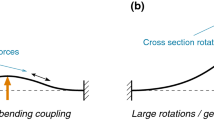Abstract
Geometric tools are developed for two-dimensional (2-D) models in an implicit Fornasini–Marchesini form. In particular, the structural properties of controlled and conditioned invariance are defined and studied. These properties are investigated in terms of quarter-plane causal solutions of the implicit model given compatible boundary conditions. The definitions of controlled and conditioned invariance introduced, along with the corresponding output-nulling and input-containing subspaces, are shown to be richer than the one-dimensional counterparts. The analysis carried out in this paper establishes necessary and sufficient conditions for the solvability of 2-D disturbance decoupling problems and unknown-input observation problems. The conditions obtained are expressed in terms of output-nulling and input-containing subspaces, which can be computed recursively in a finite number of steps.
Similar content being viewed by others
References
Basile G., Marro G. (1969) Controlled and conditioned invariant subspaces in linear system theory. Journal of Optimization Theory and Applications 3(5): 306–315
Basile G., Marro G. (1992) Controlled and conditioned invariants in linear system theory. Prentice Hall, New Jersey
Bernhard P. (1982) On singular implicit linear dynamical systems. SIAM Journal of Control and Optimization 20(5): 612–633
Conte, G., & Perdon, A. (1988a). On the geometry of 2D systems. In: Proceedings of the IEEE international symposium on circuit and systems, Helsinki.
Conte G., Perdon A. (1988b) A geometric approach to the theory of 2-D systems. IEEE Transactions on Automatic Control AC-33: 946–950
Conte G., Perdon A., Kaczorek T. (1991) Geometric methods in the theory of singular 2D linear systems. Kybernetika 27: 263–270
Fornasini E., Marchesini G. (1976) State-space realization theory of two-dimensional filters. IEEE Transactions on Automatic Control AC-21(4): 484–492
Fornasini E., Marchesini G. (1978) Doubly-indexed dynamical systems: State-space models and structural properties. Mathematical Systems Theory 12: 59–72
Hautus, M. L. J. (1982). Controlled invariance in sytems over rings, Lecture notes in control and information sciences (Vol. 39). Berlin: Springer
Kaczorek T. (1988) Singular general model of 2D systems and its solutions. IEEE Transactions on Automatic Control AC-33: 1060–1061
Karamanciog~lu A., Lewis F. L. (1992) Geometric theory for the singular Roesser model. IEEE Transactions on Automatic Control AC-37(6): 801–806
Lewis F. L. (1992) A tutorial on the geometric analysis of linear time-invariant implicit systems. Automatica 28: 119–137
Malabre M. (1989) Generalized linear systems: Geometric and structural approaches. Linear Algebra and Its Applications 122–124: 591–621
Ntogramatzidis L. (2008) Self-bounded output-nulling subspaces for non strictly proper systems and their application to the disturbance decoupling problem. IEEE Transactions on Automatic Control 53(1): 423–428
Ntogramatzidis L. (2012) Structural invariants of two-dimensional systems. SIAM Journal on Control and Optimization 50(1): 334–356
Ntogramatzidis, L., & Cantoni, M. (2011). Structural invariants for implicit two-dimensional systems, In Proceedings of the 7th international workshop on multidimensional (nD) systems (NdS 2011), France: Poitiers, September 5–7.
Ntogramatzidis L., Cantoni M. (2012) Detectability subspaces and observer synthesis for two-dimensional systems. Multidimensional Systems and Signal Processing 23: 79–96
Ntogramatzidis L., Cantoni M., Yang R. (2008) A geometric theory for 2-D systems including notions of stabilisability. Multidimensional Systems and Signal Processing 19: 449–475
Trentelman, H. L., Stoorvogel, A. A., & Hautus, M. (2001). Control theory for linear systems. Communications and control engineering. London: Springer
Willems J. (1981) Almost invariant subspaces: An approach to high gain feedback design—part II: Almost conditionally invariant subspaces. IEEE Transactions on Automatic Control AC-26(1): 235–252
Wonham W. M. (1982) Linear multivariable control: A geometric approach. Springer, New York
Yang R., Ntogramatzidis L., Cantoni M. (2009) On the realisation of 2-D linear systems with recursively computable latent variable models. IEEE Transactions on Circuits and Systems: I 56(3): 644–652
Author information
Authors and Affiliations
Corresponding author
Additional information
This work was partially supported by the Australian Research Council (DP0986577 and FT12010060).
Rights and permissions
About this article
Cite this article
Ntogramatzidis, L., Cantoni, M. Geometric techniques for implicit two-dimensional systems. Multidim Syst Sign Process 24, 601–620 (2013). https://doi.org/10.1007/s11045-012-0205-4
Received:
Revised:
Accepted:
Published:
Issue Date:
DOI: https://doi.org/10.1007/s11045-012-0205-4




